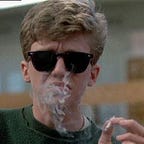Prince of Darkness (1987)
John Carpenter’s 1987 horror film Prince of Darkness is the chilling adventure of Satan (or in this case “the anti-god’s son) unleashing pure evil upon planet Earth, and the attempts of science and religion to hold back his devastation. Released just a year after Carpenter’s big-budget flop Big Trouble in Little China (1986), Prince was JC’s return to independence. With a budget of only $3 million, shot over the course of 30 days, Carpenter manages to push the limits of his craft beyond monetary constraints, forcing meaning into every shot and innovating within his means.
The technical mastery on display here is truly impressive given the film’s budget — the mirror scene at the top of this article is all practical effects, and dangerous ones at that. The crew drained mercury from the hydraulic cranes on set, and utilized a gorily made up prosthetic hand to complete the “stunt”. The scene following it involved an actress holding her breath for longer than she was comfortable with, under a covered swimming pool. It shows the real danger actors went through before widespread CGI, and the industry on the whole’s commitment to their craft. The green goo vat and Alice Cooper’s impaling are masterfully done as well, perfectly setting the tone for the even more horrific scenes to come, like worm cups and bug men that also couldn’t have been easy to execute.
An interesting parallel came up in the research of this movie, regarding Carpenter’s commentary on Rio Bravo (1959) and on his own Prince. On the Rio Bravo commentary, he notes that director Howard Hawks, a big inspiration for Carpenter, “is a director whose camera is always in the right place at the right time.” On his Prince of Darkness commentary: “It’s one of my most-controlled films visually. Every shot I can see, every shot is basically set to a purpose, where in some films I will let things go.” I thought this a quaint sort of unconscious recognition of Hawks’s influence on Prince, even if they are wildly different movies in terms of tone and subject matter. There is a similarity here in how Carpenter uses characters, and especially their dialogue and interactions to the 50’s Hawks style. Joshua Rothkopf, for Oscilloscope even notes some Hawks-ian dialogue from the character of Brian in this film.
Thematically, Prince of Darkness grapples with the convergence of science, religion, and horror, in a way that truly blurs the lines between what makes each of those scary. It’s not a film in which science is ill-equipped to understand a grander supernatural threat, rather, our characters explain thoroughly, in all their lab coat jargon, the scope of what they’re about to face. The evil they face is subatomic, living in every nanoparticle of space and time, a conceit to the religious idea of man’s fallen state perhaps. But this is what brings about the true horror of this film, the idea that perhaps neither science nor religion is wrong, but one is simply waiting to prove all that is terrifying about the other. Truly Prince of Darkness aims to bring the viewer into a nightmare scenario — scientific proof of the Devil and his works.
The film’s last moments are the ones that will keep you up at night. The shattering of the mirror, leaving Lisa Blount drifting into endless darkness. Jameson Parker awaking from a more than disconcerting dream (claiming to be a transmission from 12 years in the future). Immediately awaking from a second dream in which he sees Lisa Blount’s fleshless body lying next to him. His final reaching out to the mirror and its subsequent hard cut to a black screen. Prince of Darkness isn’t a horror movie meant to scare you, it’s a movie meant to terrify you — not in a going down a roller coaster way, in a you’ve lost everything and you don’t know what’s real way.
